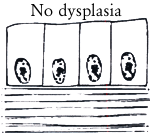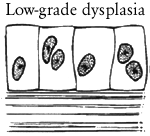|
For Patients
Barrett's Oesophagus Risk Factors
Progression to Cancer
The information below is intended to provide you with a general understanding of the progression of Barrett's oesophagus to cancer. Refer to a medical professional for more detailed information and to address any questions you may have.
Barrett's oesophagus has three stages prior to its progression to oesophageal cancer:
1. Intestinal metaplasia (IM)
The tissue cells have begun to change genetically and the tissue resembles the red intestinal lining rather than the normal and healthy pink oesophagus lining. At this stage, a person has Barrett's oesophagus, but has not developed Dysplasia, the next stage. |
 |
2. Low-grade Dysplasia (LGD IM)
Less than 50% of the abnormal cells have begun to change in size, shape, or organization and may show an increase in their growth rate. The cells are contained within the lining of the oesophagus and have not spread to other areas. |
 |
3. High-grade Dysplasia (HGD IM)
As with LGD, the abnormal cells reside within the lining of the oesophagus. But more than 50% of these cells do demonstrate a higher increase in abnormal growth rate and pattern. |
 |
4. Adenocarcinoma (Oesophageal Cancer)
When the abnormal cells have a rapid and uncontrolled growth rate. The cells also invade the deeper layers of your oesophagus and may spread beyond that. These cells can develop into malignant tumors.
Adenocarcinoma can also be classified in different stages or categories. Contact your physician for more information.
|
 |
|
Barrett's Disease
|
Barrett's Oesophagus
|
Barrett's Esophagus
|
Barrett's 0esophagus
|
Barrett's Esophagitis
|
|
Barratts Disease
|
Barratts Oesophagus
|
Barretts Esophagus
|
Barretts 0esophagus
|
Oesophageal Cancer
|
|
|
|

